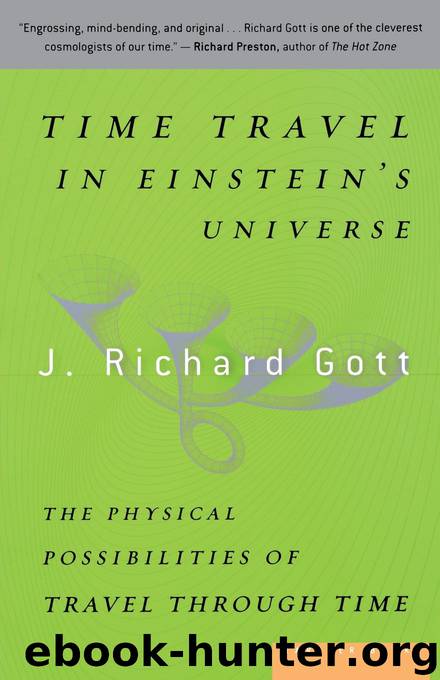Time Travel in Einstein's Universe by J. Richard Gott

Author:J. Richard Gott
Language: eng
Format: epub
Publisher: Houghton Mifflin Harcourt
Published: 2015-08-30T16:00:00+00:00
The Big Bang
Edwin Hubble, working with the 100-inch-diameter telescope on Mount Wilson in California, made not one, but two, landmark discoveries. First, he found that our galaxy, a spinning pinwheel of some 400 billion stars, was not alone in the universe. He proved that many spiral-shaped nebulae, previously thought by some to be glowing clouds of gas within our own galaxy, were actually other galaxies like ours. He proved his case by identifying faint variable stars in the Andromeda nebula that were just like similar stars seen in our own galaxy; but these were very faint, proving the nebula was very far away. Our galaxy, the Milky Way, is about 100,000 light-years across. Andromeda, our galaxy’s slightly larger sibling, is 2 million light-years away. The Milky Way, together with Andromeda and a couple dozen other smaller galaxies, form our Local Group of galaxies. Hubble found the galaxies beyond were sprinkled throughout space in all directions as far as his telescopic eye could see. He classified them by type—spirals, ellipticals, and irregulars—like some lucky biologist cataloging creatures for the first time. Just as Leeuwenhoek discovered the microscopic world, Hubble discovered the macroscopic universe.
Then even more news jarred Einstein’s concept of the universe. Vesto M. Slipher of the Lowell Observatory in Flagstaff, Arizona, measured the velocities of more than 40 galaxies, finding that most were moving away from us. This is how such movement can be measured. A prism can be used to spread the light from a galaxy into a spectrum showing the different colors. Lines in the spectrum appear corresponding to light emission or absorption by specific chemical elements at specific wavelengths. If spectral features of known chemical elements were shifted slightly toward the red (long-wavelength) end of the spectrum (a Doppler shift), then the galaxy was moving away from us. Waves coming from a galaxy moving away will be stretched or lengthened (shifted to the red end of the spectrum) because of the steadily lengthening distance to the galaxy. A shift toward the blue, however, meant the galaxy was approaching us. While the Andromeda galaxy showed a blueshift, falling back toward us in a long and lazy orbit, Slipher found that redshifted galaxies far outnumbered blueshifted galaxies. Hubble investigated this further and found that the more distant galaxies were receding from us more rapidly. By 1931 he and his associate Milton Humason had found a galaxy receding from us at the astonishing speed of nearly 20,000 kilometers per second. A galaxy’s velocity while moving away from us was approximately proportional to its distance from us, a relationship Hubble first noted in 1929, and in 1931 cemented with much more dramatic data extending to greater distances. The farther away a galaxy was, the smaller it would appear in the sky, and the greater would be its velocity in receding from us. These galaxies were, according to a famous analogy, like raisins in some giant loaf of raisin bread baking in the oven. As the loaf expands, each raisin moves apart from the others.
Download
This site does not store any files on its server. We only index and link to content provided by other sites. Please contact the content providers to delete copyright contents if any and email us, we'll remove relevant links or contents immediately.
The Complete Stick Figure Physics Tutorials by Allen Sarah(7338)
Secrets of Antigravity Propulsion: Tesla, UFOs, and Classified Aerospace Technology by Ph.D. Paul A. Laviolette(5333)
Thing Explainer by Randall Munroe(3910)
The River of Consciousness by Oliver Sacks(3572)
The Order of Time by Carlo Rovelli(3162)
How To by Randall Munroe(3074)
A Brief History of Time by Stephen Hawking(2992)
I Live in the Future & Here's How It Works by Nick Bilton(2960)
What If?: Serious Scientific Answers to Absurd Hypothetical Questions by Randall Munroe(2670)
The Great Unknown by Marcus du Sautoy(2663)
Midnight in Chernobyl by Adam Higginbotham(2516)
Blockchain: Ultimate Step By Step Guide To Understanding Blockchain Technology, Bitcoin Creation, and the future of Money (Novice to Expert) by Keizer Söze(2467)
Networks: An Introduction by Newman Mark(2382)
The Meaning of it All by Richard Feynman(2319)
Easy Electronics by Charles Platt(2308)
The Tao of Physics by Fritjof Capra(2247)
Midnight in Chernobyl: The Untold Story of the World's Greatest Nuclear Disaster by Adam Higginbotham(2196)
When by Daniel H Pink(2098)
Introducing Relativity by Bruce Bassett(2097)
